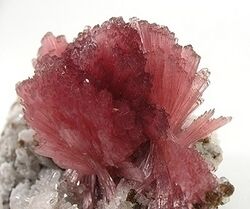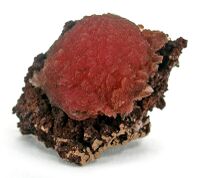Chemistry:Inesite
From HandWiki
| Inesite | |
|---|---|
 Inesite Crystals from Fengjishan Mine (Daye Copper Mine), Edong Mining District, Daye County, Huangshi Prefecture, Hubei Province, China. | |
| General | |
| Category | Inosilicates |
| Formula (repeating unit) | Ca2Mn7Si10O28(OH)2•5(H2O) |
| Strunz classification | 09.DL.05 |
| Dana classification | 66.3.3.1 |
| Crystal system | Triclinic |
| Space group | P1 (no.2) |
| Identification | |
| Color | Rose red, pink, orange-pink, orange-red-brown |
| Crystal habit | Massive, fibrous, radial, spherical |
| Cleavage | Perfect |
| Fracture | Irregular/Uneven |
| Tenacity | Brittle |
| Mohs scale hardness | 5.5 - 6 |
| |re|er}} | Vitreous, Silky |
| Streak | White |
| Diaphaneity | Translucent |
| Specific gravity | 3.0 |
| Ultraviolet fluorescence | Non-fluorescent |
| Common impurities | Fe, Al, Mg, K |
| References | [1][2][3] |
Inesite is a hydrous calcium manganese silicate mineral.[5] Its chemical formula is Ca2Mn7Si10O28(OH)2•5(H2O). Inesite is an inosilicate with a triclinic crystal system. It has a Mohs hardness of 5.5 to 6, and a specific gravity of 3.0. Its name originates from the Greek Ίνες (ines), "fibers" in allusion to its color and habit. [2]
Occurrence and distribution
Inesite occurs in hydrothermal replacement deposits of manganese-rich metamorphic rocks and serpentines.[6] It was first described in 1887 at Hilfe Gottes Mine, Oberscheld, Dillenburg, Dillenburg District, Hesse, Germany. Outside of the type locality, there are several notable localities of inesite, such as:[7][8]
- Wessels and N'Chwanning Mines, Kalahari Manganese Field, Northern Cape, South Africa where Inesite is associated with datolite, pectolite, apophyllite, ruizite, orientite and quartz.
- Broken Hill, New South Wales, Australia.
- Långban, Persberg, Värmland, Sweden.
- Kawazu Mine, Shizuoka Prefecture, Chubu Region, Honshu Island, Japan
- Hale Creek Mine, Trinity County, California, USA, where Inesite is associated with Rhodochrosite, bementite, and hausmannite.
- Fengjishan Mine (Daye Copper Mine), Edong Mining District, Daye County, Huangshi Prefecture, Hubei Province, China.
Inesite Gallery
References
- ↑ Dave Barthelmy. "Inesite Mineral Data". http://www.webmineral.com/data/Inesite.shtml#.XEvCI89Kjq1.
- ↑ 2.0 2.1 "Inesite: Mineral information, data and localities". https://www.mindat.org/min-2031.html.
- ↑ Wan, C.; Ghose, S. (1978). "Inesite, a hydrated calcium manganese silicate with five-tetrahedral-repeat double chains". American Mineralogist 63: 563–571.
- ↑ Warr, L.N. (2021). "IMA–CNMNC approved mineral symbols". Mineralogical Magazine 85 (3): 291–320. doi:10.1180/mgm.2021.43. Bibcode: 2021MinM...85..291W.
- ↑ Chesterman, Charles (1978). The Audubon Society Field Guide to North American Rocks And Minerals. Knopf. pp. 592.
- ↑ The Mineral Inesite
- ↑ "Inesite". 18 August 2001. http://rruff.info/doclib/hom/inesite.pdf.
- ↑ http://www.minsocam.org/ammin/AM53/AM53_1614.pdf Inesite From the Broken Hill Lode, New South Wales, Australia
 |






